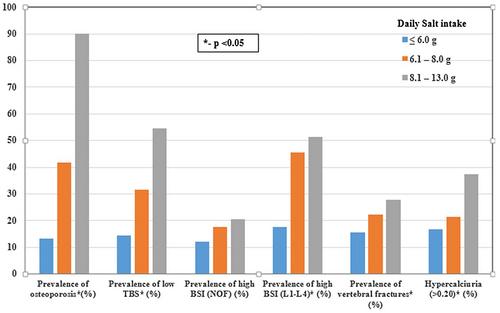Excess dietary salt is associated with an altered bone strain index, degraded bone microarchitecture, vertebral fractures, and increased prevalence of osteoporosis in postmenopausal women—A study from a teaching hospital in southern India
Abstract
Objectives
Excess dietary salt causes increased urinary calcium and this may lead to bone loss. We proposed to study the association between dietary salt intake and bone health in postmenopausal women from southern India.
Methods
An observational study in which community-dwelling postmenopausal women were recruited. Daily salt intake and urine calcium/creatinine ratio were assessed. Bone biochemistry and densitometric parameters such as bone mineral density (BMD), trabecular bone score (TBS) vertebral fractures, and bone strain index (BSI) were assessed using Dual Energy X-Ray Absorptiometry (DXA).
Results
A total of 383 postmenopausal women with a mean ± SD age of 59.8 ± 7.2 years and BMI of 25.2 ± 4.6 kg/m2 were recruited. Among the participants, 165/383(43.1%) had osteoporosis at any site and 21% had moderate–severe vertebral fractures. The BMD at lumbar spine and femoral neck, TBS and BSI were significantly (p < 0.001) lower and the CTx was significantly (p = 0.008) higher among women with high salt intake (7.2 g/day) as compared to those with salt intake of <7.2 g/day. The prevalence of osteoporosis, low TBS, high BSI, and moderate–severe vertebral fractures significantly increased across low to high salt-intake categories. An ROC analysis showed that excess dietary salt was significantly associated with osteoporosis at any site with an AUC of 0.870 (95% CI: 0.832–0.907). On a multivariate analysis, excess salt intake conferred the highest odds of osteoporosis (OR: 2.296; 95% CI: 1.909–2.761).
Conclusions
Excess dietary salt is associated with high urinary calcium and compromised bone health among postmenopausal women from southern India. This may be a modifiable risk factor in osteoporosis and warrants further research.


 求助内容:
求助内容: 应助结果提醒方式:
应助结果提醒方式:


